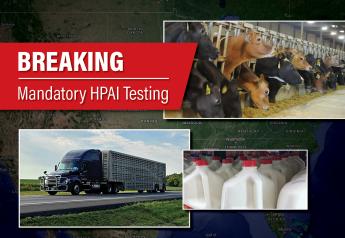On-Farm Dry Matter Testing Pays

Getting the right amount of each type of feed into the total mixed
ration (TMR) mixer is critical to creating a balanced ration.
Everyone knows that. But to do it, you have to know the dry matter content of ingredients, especially forages stored in bunkers unprotected from the weather.
While university nutrition specialists recommend weekly testing for forage dry matter, it’s a job that is
seldom done that often. Typically, dry matters are checked once or twice month at most.
Yet research from Penn State shows corn silage dry matter can vary widely—by as much as 10 percentage points over the course of a day or two. Even two or three percentage points can make a difference in the actual amount of dry matter feed a cow is offered and consumes, says Mathew Hann, a dairy educator with Penn State.
“If a ration calls for 50 lb. of corn silage on an as-fed basis and dry matter (DM) is
assumed to be 33%, 16.5 lb. of corn silage DM will be fed,” he says. “For each one-point deviation of the actual percent dry matter from the assumed percent dry matter, the dairy farmer will over or under feed 0.5 lb. of corn silage per cow per day. If the actual dry matter of the corn silage is 28%, the cows will only receive 14 lb. of corn silage on a dry matter basis.”
Taking dry matters frequently is critical to ensure cows are getting the ration they need. An Italian company, Dinamica General, has developed a near-infrared (NIR) analyzer that can be mounted in the bucket of a tractor, skid steer or front-end loader.
The On-Farm NIR Analysis One system analyzes each bucket load for dry matter (along with crude protein, NDF, ADF, ash, fat and starch). And then, software tells the operator how much silage to add to the TMR for more precise feeding.
An Italian study then compared farms using the system to those that didn’t. The study found feed costs were 9¢ per cow per day less and milk production was 5.6 lb. per cow per day higher for those farms that used the system.
“For a 200-cow dairy, this would result in approximately $73,584 of increased revenue from milk sales (assuming $18 per cwt milk) and a $6,570 savings in feed cost per year,” Hann says.
Increased production was attributed to a more consistent ration being delivered to the herd. Lower feed cost was attributed to being able to feed more precisely to the needs of the herd and thus decreasing feed waste.
“The study also reported an improvement in the general health of the herd, based on changes in blood parameters and a reduction in mastitis,” Hann says.
And on a per-cow basis, it could add up to a $400 increase in profit—all from precisely feeding cows what they should be fed.







